NEW ZEALAND BLOG - WEEK 5
Click on the thumbnails to see an enlarged picture.
Tuesday 17th Feb
Not a cloud in the sky when we woke up this morning and we could just see Mount Cook from the cabin at the holiday park. 15 minutes later it had disappeared in cloud. Just a short ride up the road this morning to the Fox Glacier car park and from there a short stroll to the base of the glacier. The sun was shining brightly and photography was difficult because of the strong contrast between sky/snow and mountainside. We had 200kms to travel today so after the glacier we started to make our way southwards along the coast - hardly any towns to speak of but some beautiful beaches. The first we stopped at was Bruce Bay. It seems to be the tradition here to erect little pebble cairns - the sort you would build at the seaside to throw pebbles at. Here they are left for the elements and so there are rows of them along the seafront. Later on in the morning we stopped for a longish walk to the Monro Beach - a glorious beach, very secluded, and the possibility of seeing Fiordland Crested Penguins - none around today. By 2pm we had reached Haast the first town of any size. But Haast only had a small village store and we struggled to find anything worth having for dinner. So on to Makarora via the Haast Pass stopping off along the way at waterfalls and even more creative cairns. When we arrived at the Makarora Wilderness Resort, where we were staying, we found out that it has a restaurant. On the menu was a roast carvery which soon persuaded us to abandon our measly pickings from Haast - the first roast of the holiday! |
|
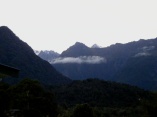 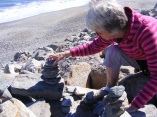 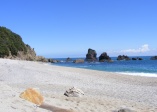  |
Wednesday 18th Feb
During the night, on our toilet visit (no toilets in the chalet), we marvelled at the number of stars that we could see from Makarora. What a pity there is so much light polution in England. Another cloudless sky greeted us in the morning and all was calm as we made our way alongside Lake Wanaka. The scenery has changed dramatically - from lush green almost tropical vegetation further up the coast, to a very dry and barren landscape with very few trees or green of any kind - but is still spectacular especially around the lakes. After a brief stop for tea and muffin in Wanaka we took the back road to Cromwell by the side of Lake Dunstan. This is a man made lake created in the 1980s by a dam downstream at Clyde. The result is a very long lake and the creation of a new town at Cromwell - the old town is beneath the water but several of the old houses have been preserved and moved to higher ground. We stopped at the northern end of the lake to have our lunch and to watch the birds - New Zealand Scaup, Australasian Grebe and Pied Stilt close by but many other varieties in the distance. Eventually we moved on stopping briefly at the dam and then continuing into Clyde. |
|
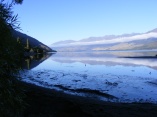 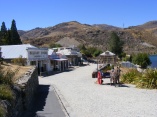 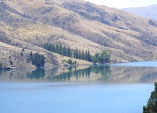 |
Thursday 19th Feb
A hot day was forecast so we decided on an early start for the cycle ride. The hire company opened their doors at 8.00 - we were kitted out, loaded up and ready for off by 8.30. The track surface is rougher than we are used to riding on, but the tandem, with its wider tyres, coped well. We soon passed Alexandra and were cycling through spectacular scenery, across the old Manorburn Bridge and by 11.00 we had reached Chatto Creek (25km). The Tavern at Chatto was just opening as we arrived and we enjoyed a cup of tea and a chat with our hostess. The tavern seemed to be the only building in the village except for the old post office next door which had been saved and returned to its original site. We found out that the pub serves a community of roughly 150 people who live in the surrounding area. By lunchtime we had readed Omakau and left the railway track to visit the adjacent town of Ophir. This town sprung into life almost overnight when gold was discovered on a local property in 1863. When the gold dwindled so did the population but many of its historic buildings survive. The temperature was approaching 30 degrees by the time we had finished the day's ride at the Muddy Creek Cutting just outside Lauder (total 45km). |
|
 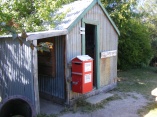 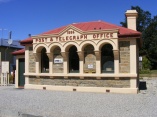 |
Friday 20th Feb
What a difference a day can make! We awoke to cloud and rain and a much lower temperature which rose to a maximum of 14 degrees in the middle of the day. We wrapped up in warm clothing and waterproofs and tied plastic carrier bags round our feet in an effort to keep them dry. The track degenerated under the wet conditions and riding was more difficult. There were two long tunnels to negotiate - the first had a bend in it. Fortunately we had a small torch, thanks to Barry and Fran, but a party of cyclists with better lights arrived at the first tunnel at about the same time as us and we followed them through. The second tunnel was straight and we could see the light at the end which made riding easier. We were extremely glad to arrive at Oturehua where we stopped for refreshments at Gilchrist's, NZ's oldest continuously operating general store. The rain got much heavier as we left and was stinging our faces as the wind became stronger. Long straight sections take the trail across 'big sky country' of the Maniototo Plain and at last we passed the summit at 618m and began the descent to Wedderburn where we decided to have something hot for lunch. By this time we were cold and wet - the anticipation of a hot shower at Ranfurly kept us going over the final section (total 48km). |
|
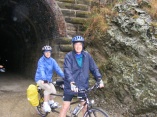 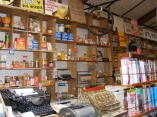 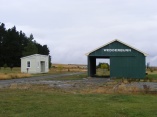 |
Saturday 21st Feb
Strong winds and rain continued through the night and the temperature dropped even lower the next day. The prospect of cycling 60km with the wind in our faces in these conditions was daunting so we decided to spend the day at Ranfurly and abandon the rest of the ride. We were a bit disappointed but there happened to be a 'Rural Art Deco Weekend' (an annual event) taking place in the town so we had something to keep us occupied until the bus arrived to pick us up later in the afternoon. Ranfurly, originally established as a railway town, developed rapidly at the beginning of the 1900s with buildings constructed mainly of wood. However a series of unexplained fires in the early 1930s destroyed a large part of the town and new buildings in the art deco style were constructed of concrete, plaster or brick. The event got off to a slow start due to the weather but by the afternoon it was standing room only in the local tavern which was hosting some of the events including a Country and Western group, a magician and an art deco fashion show / competition. Events were also held in the Ranfurly Hotel and there was a parade of period cars in the street outside. |
|
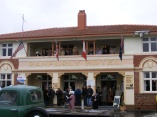   |
Sunday 22nd Feb
Still a bit cold and wet today but no wind. We retraced our steps to Cromwell and then took the road towards Queenstown following the Kawarau River, swollen as a result of the recent rain and thus flowing very rapidly through the gorge. We passed through a fruit and vine growing area - boxes of peaches and other fruit on display by the roadside and vineyards inviting custom. We turned off the main road to visit Arrowtown, a former gold mining town but now rather commercialised. The morning muffin with a cup of tea has become a habit. After a look round the shops we spent a while in the local museum reading people's accounts of their childhood in the area. Accounts of Queenstown in the guidebook didn't inspire us to visit it so we gave it a miss and found a quiet spot by Lake Wakapitu to eat our lunch and later took a short walk to the lakeside. Kingston was our destination for the day. We arrived to find that the 'Kingston Flyer' had just returned from its last trip of the day and was taking on coal in readiness for tomorrow. |
|
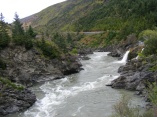  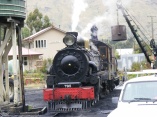 |
Monday 23rd Feb
We returned to Kingston Station in the morning to see the 10.00am departure of the 'Kingston Flyer' (another excuse to take a photo for Peter and Daniel). Then we travelled on towards Te Anau, which is in the Fiordland National Park. A few kilometers from the town we stopped at a scientific nature reserve - what we would call an SSSI. It is a unique area of native shrubland the like of which is quickly disappearing from many areas of NZ. We found out that the shrubs here are very slow growing, the largest being more than 100 years old and yet only 1m high. The rest of the day was spent in the town of Te Anau. The weather has remained cold and showery but we did see the sun today for brief intervals. The forecast is better for tomorrow when we travel to Doubtful Sound. We did venture out for a short walk to the Wildlife reserve at Te Anau where several species of birds are kept in captivity including the endangered Takahe which for a period of 50 years was thought to be extinct. The Takahe we photographed is an antique specimen being around 20 years old and rather doddery! Unfortunately the only shot I could get was through a glass viewing window. |
|
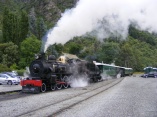  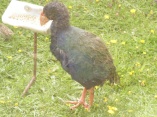 |
Return to Blog Index Goto Week 6
Page updated 23rd February 2009